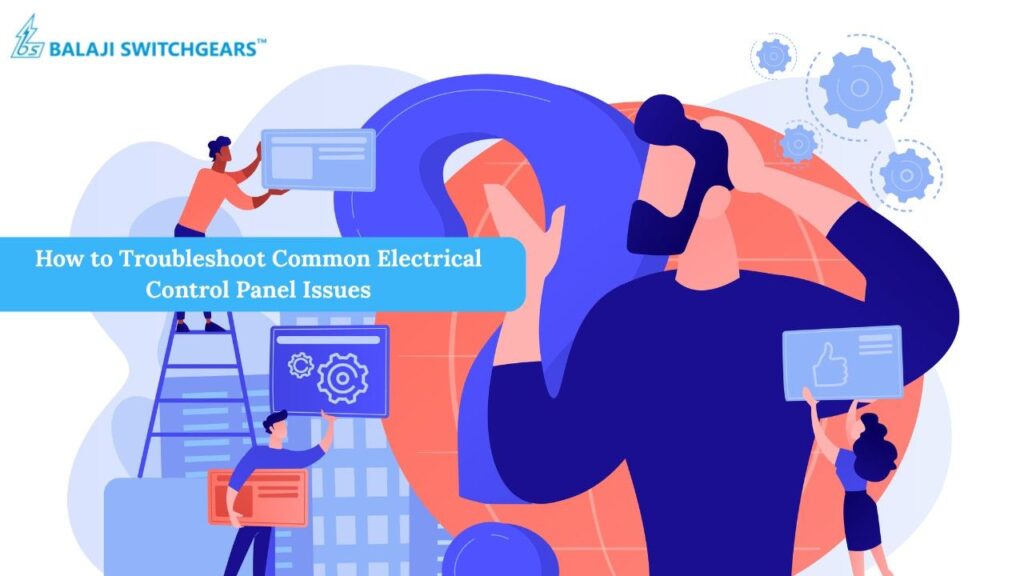An Electrical Control Panel is the heart of any industrial setup. It houses switches, relays, timers, PLCs, fuses, and circuit breakers that control machinery and processes. When these panels encounter issues, it can result in downtime, safety risks, and costly repairs. The good news? Many problems can be identified and resolved with a structured troubleshooting approach.
In this blog, we’ll walk through the most common control panel issues, practical troubleshooting tips, and preventive steps every engineer and plant operator should know.
Understanding Electrical Control Panels
An Electrical Control Panel is essentially the command center for machines and processes. It regulates power distribution, monitors inputs and outputs, and ensures smooth operation of motors, pumps, conveyors, and other equipment.
Components typically found inside a control panel include:
- Circuit breakers and fuses (protection devices)
- Contactors and relays (switching devices)
- PLCs and timers (logic and automation control)
- Power supplies and transformers
- Wiring, terminals, and bus bars
Given the critical role these panels play, even a minor fault can disrupt operations significantly.
Common Issues in Electrical Control Panels
1. Loose or Damaged Wiring
Over time, vibration, temperature changes, and wear can loosen connections. This may cause:
- Intermittent machine stoppages
- Sparks or overheating at terminals
- Voltage drops leading to malfunction
Troubleshooting Tip:
Inspect terminals, tighten screws, and replace damaged wires. Always check for signs of overheating or discoloration around connectors.
2. Overloaded Circuits
When too many devices draw current beyond the panel’s rated capacity, protective devices trip frequently. Overloading can also damage sensitive components.
Troubleshooting Tip:
Measure current draw with a clamp meter. Redistribute loads or upgrade to a higher-rated electrical control panel.
3. Faulty Circuit Breakers or Fuses
A tripped breaker or blown fuse is often the first sign of an issue. Causes can range from short circuits to ground faults.
Troubleshooting Tip:
Identify whether the trip was due to overload or a genuine fault. Replace only with components of the same rating to avoid hazards.
4. Defective Contactors and Relays
Contactors and relays handle frequent switching. Worn contacts can result in chatter, failure to engage, or overheating.
Troubleshooting Tip:
Check coil resistance and inspect contacts for pitting or carbon buildup. Replace faulty relays promptly to avoid further failures.
5. PLC Malfunctions
Programmable Logic Controllers (PLCs) form the “brain” of many modern panels. Faulty I/O modules, corrupted programs, or power supply issues can halt operations.
Troubleshooting Tip:
Review diagnostic LEDs on the PLC. Connect to the software to check for program errors. Ensure backup copies of programs are available.
6. Overheating
Panels generate heat, especially when operating continuously. Poor ventilation, blocked filters, or high ambient temperatures can cause overheating.
Troubleshooting Tip:
Check for adequate airflow. Clean cooling fans and filters. If necessary, add air conditioners or heat exchangers to the control panel.
7. Grounding and Short Circuits
Improper grounding or damaged insulation can lead to dangerous short circuits. Symptoms include frequent tripping, burning smells, or visible sparks.
Troubleshooting Tip:
Inspect insulation, measure resistance with a megger, and verify grounding is done according to standards.
8. Human Error in Operation
Incorrect switch settings, poor labeling, or untrained staff can cause preventable breakdowns.
Troubleshooting Tip:
Ensure clear labeling inside the electrical control panel, provide operator training, and implement lockout/tagout procedures during maintenance.
A Step-by-Step Approach to Troubleshooting
- Safety First
Always de-energize the panel before inspection. Use PPE, insulated tools, and follow lockout/tagout procedures. - Visual Inspection
Look for obvious signs like burnt marks, loose wires, tripped breakers, or unusual smells. - Check the Power Supply
Confirm incoming power voltage matches the panel’s requirement. Fluctuations may point to upstream supply issues. - Isolate the Faulty Circuit
Break down the problem by sections—protection devices, control devices, and loads. - Test Components
Use a multimeter to test continuity, resistance, and voltage at critical points. - Refer to Schematics
Always keep updated wiring diagrams handy. Schematics save time in identifying connections and fault locations. - Restore Gradually
Once repairs are made, power up the system step by step, checking each stage for proper function.
Preventive Measures for Long-Term Reliability
- Regular Maintenance: Schedule inspections for tightening connections, cleaning dust, and checking insulation.
- Environmental Control: Ensure enclosures are sealed against dust, humidity, and corrosive gases.
- Thermal Management: Maintain cooling systems to prevent overheating.
- Use Quality Components: Investing in branded parts increases reliability.
- Documentation: Keep records of faults, repairs, and upgrades to track recurring issues.
Real-World Example
Imagine a manufacturing unit where a motor kept tripping unexpectedly. On inspection, engineers found a loose wire in the control panel terminal feeding the motor contactor. A simple tightening fixed the recurring downtime issue.
This shows that even small issues in an electrical control panel can have a significant operational impact.
Conclusion
Troubleshooting an electrical control panel requires patience, systematic inspection, and a good understanding of how components interact. From loose wiring to faulty PLCs, most issues can be resolved by following a logical approach. By combining preventive maintenance with skilled troubleshooting, industries can reduce downtime and keep systems running at peak efficiency.
A well-maintained control panel is not just about reliable operations—it’s about safety, productivity, and long-term cost savings.

